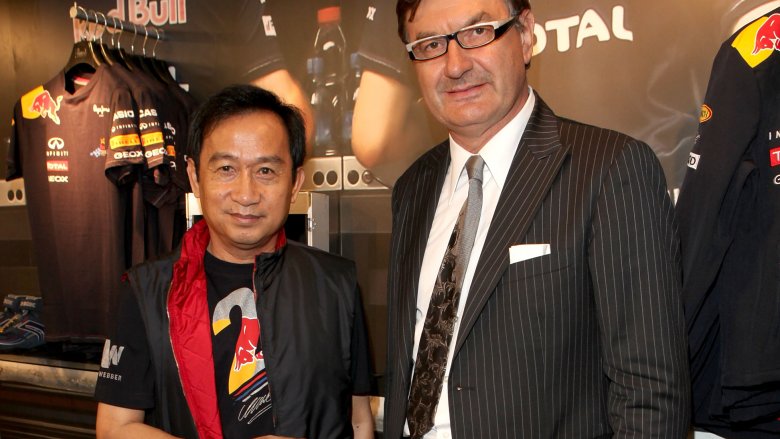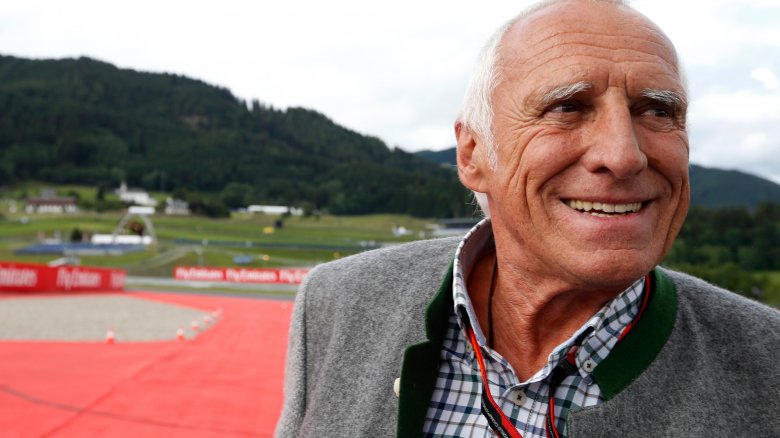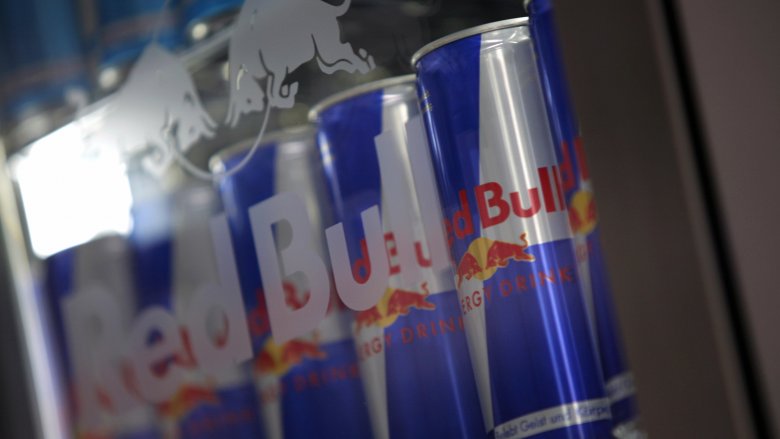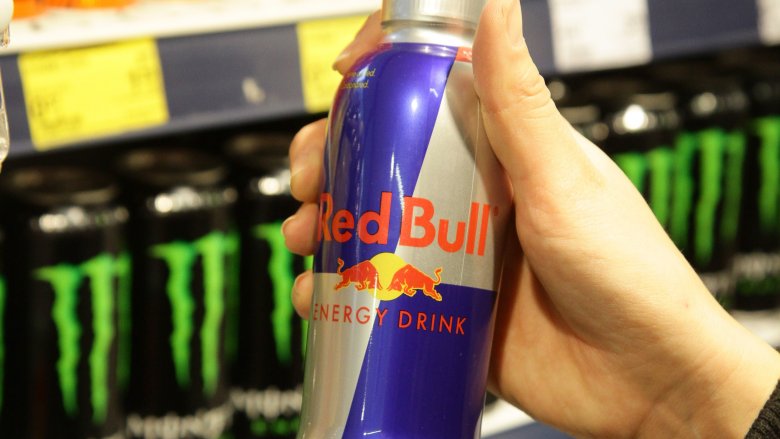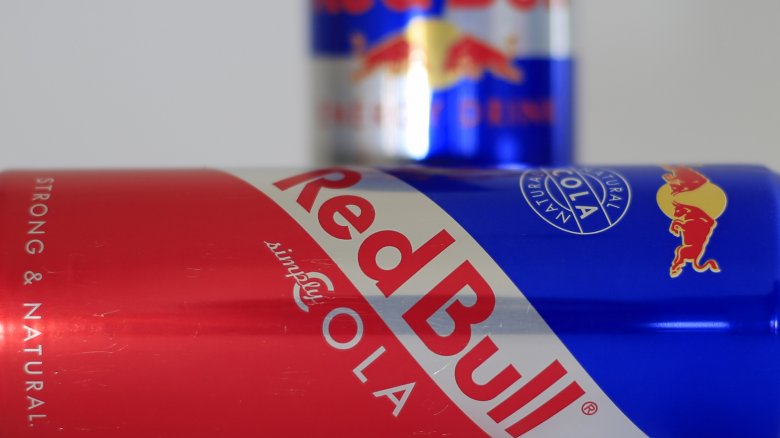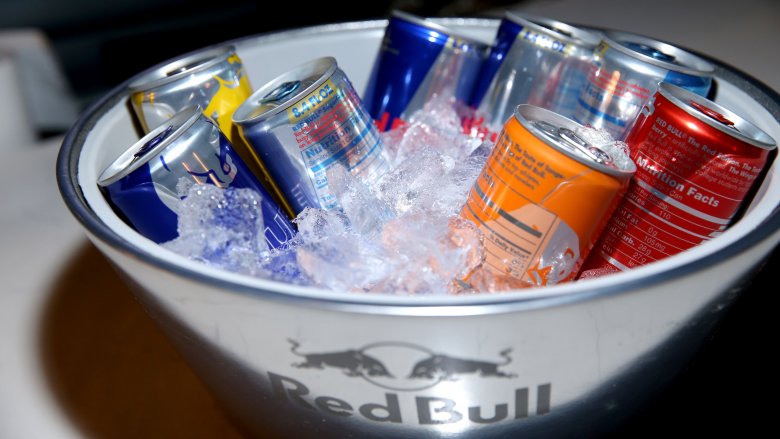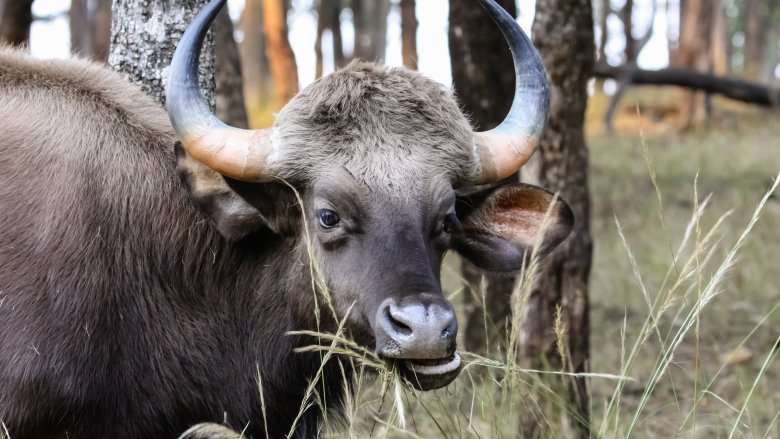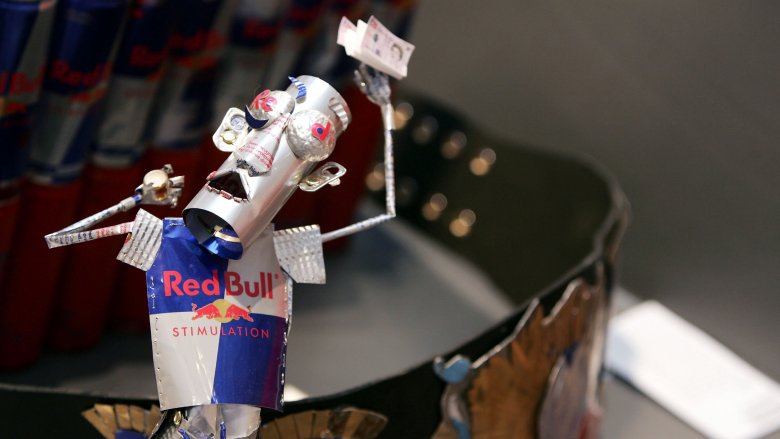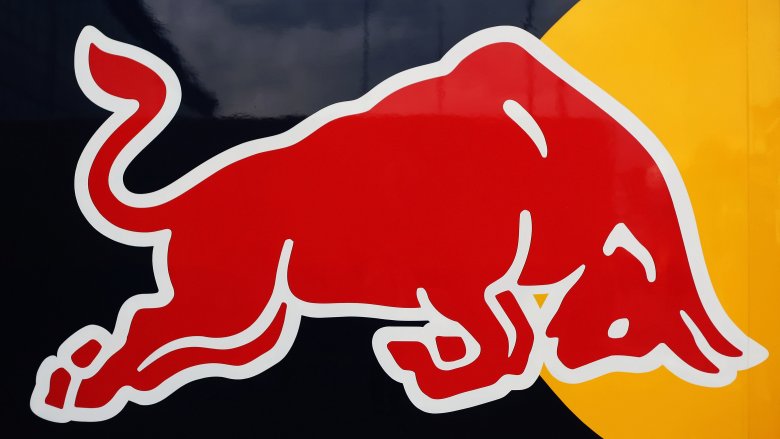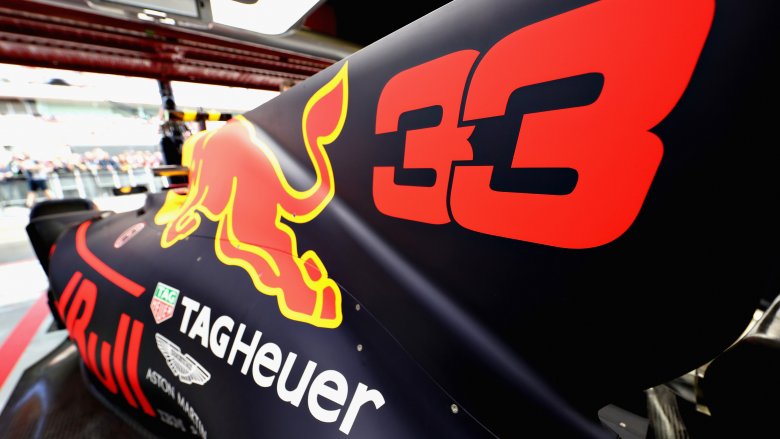The Untold Truth Of Red Bull
Whether you're the type that can't imagine a trip to the grocery store or gas station without grabbing an energy drink or if you rely on them only for an occassional emergence pick-me-up, you're familiar with the distinct taste of Red Bull. It's gone from being the drink of choice for truck drivers in Thailand to a global phenomenon, and you might be surprised at some of the things about the drink — and its creators — that you've never heard.
Its inventor was from incredibly humble beginnings
Red Bull is pretty much everywhere today, which makes it easy to forget that it definitely hasn't been around forever, and its invention is actually an unlikely story.
The original Red Bull is called Krating Daeng, and it was created by an entrepreneur in Thailand. Chaleo Yoovidhya created the energy-imbuing blend in 1976, and it took the top spot among the country's energy drinks within two years. As the saying goes, timing is everything, and Chaleo's creation came when there was a surge in people who were trying to stay awake and productive. The economy was facing a nationwide industrialization, and its citizens needed something to help them make the transition from rural lifestyle to urban jobs — especially blue-collar ones. Truck drivers were among the first targeted by the brand, and its popularity skyrocketed.
Part of his success hinged on the idea that he wasn't just selling a product, he was building a brand. He also knew exactly where his clients were coming from, too, as he'd been there. Chaleo was born in 1923 to a family of Chinese immigrants who had moved to Thailand, and he counted things like duck farming among his early occupations. He founded his own company — TC Pharma — in 1956. It took almost another two decades before he started an energy drink revolution.
It went global thanks to an international toothpaste promoter
Krating Daeng wasn't an overnight, global success by any means, and it wasn't until 1987 that a completely unrelated business encounter turned it into Red Bull and introduced it to the world. Chaleo's company was working with importing product from a German toothpaste company called Blendax. When Blendax's marketing director sampled his licensee's energy drink, there was no looking back — especially after that marketing director, Austrian businessman Dietrich Mateschitz, struck upon the idea of forming a corporation specifically to bring the drink to the rest of the world.
After a bit of tweaking and translation that took a whopping three years to get just right, they started testing in the Austrian market first. Fifteen years later, the company was enjoying $1.3 billion in annual sales, all built on the shoulders of someone who had started out in the business of selling toothpaste.
It's been subject to nationwide bans
Introducing Red Bull to a global market wasn't a flawless, simple process, and even if you're from one of the countries that never had a problem putting the original Red Bull on store shelves, you've probably heard the concerns over what it does to a person's brain and body. In 2004, France raised concerns about the levels of caffeine Red Bull contains, and banned the import and sale of it completely. The ban was challenged on the grounds that it was interfering with the right to import products into the country, but based on a report from the European Court of Justice's Scientific Committee on Food that suggested more studies were needed to completely assess any health risks, the ban was upheld.
It wasn't until 2008 that the original, unmodified version of Red Bull was allowed to be imported to and sold in France, because continued testing couldn't find any evidence of the supposed health risks that had kept it out of the hands of French citizens until then.
France isn't the only one, either, and in 2014 Lithuania voted a new law into effect that took away a huge part of Red Bull's target audience: minors. The law forbid the selling of any high-caffeine energy drink (not just Red Bull) to minors.
The accusations of a conflict of interest in scientific studies
Decades after Red Bull was made available to most of the world and years after even France had gotten on board, there are still studies being done on potential risks associated with energy drinks. While other companies have also had their products targeted, it's Red Bull's influence that has some medical professionals concerned.
In 2014, Dr. Peter Miller of Australia's Deakin University published a piece in the BMJ that questioned just how honest some of these studies are. Specifically, he was concerned about investigations into what happens when you start combining energy drinks and alcohol, and whether it intensifies the affects of the alcohol. The problem, he claims, is that there are a number of studies that say Red Bull is completely safe. Read the fine print, though, and you'll find they're often financed by Red Bull themselves in what seems to be a complete conflict of interest.
Red Bull did provide a response, saying simply that no, there was no apparent increase in risks from mixing its product with alcohol. What they didn't respond to, though, were questions about providing placebos or approving studies. Other researchers have warned that studies are, in fact, rather incomplete by necessity. It's a case where laboratory conditions can't mimic real-life situations, since ethics laws place limits on just how much volunteers can be asked to drink. Those rules don't apply in real life, and that raises more concerns about just how accurate studies are.
Samples of Red Bull Cola tested positive for cocaine
Red Bull might be best known for its energy drinks, but in 2009, the company made headlines with another product. Their Red Bull Cola was making waves — and not in a good way — when testing in Germany found samples that contained trace amounts of cocaine.
News reports clarified the process behind making cola, which is made from the same coca plant that's notorious for its illicit byproducts. It's included in a number of energy drinks, but the manufacturing process removes the cocaine component... in most cases.
Even though the amount found was negligible — the German food safety department said it would take chugging an impossible 12,000 liters to get any cocaine-like effects from it — it was still banned in six German states. The ban wasn't universally supported, even within Germany, either, with Fritz Soergel, a representative from the Institute for Biomedical and Pharmaceutical Research saying that it was a completely inactive version of cocaine that was completely harmless. Still, no one likes to hear that something with cocaine is on their grocery store shelves, and the ban stood.
One company produces Red Bull flavors for the world
Everyone who's ever had a Red Bull knows exactly what it tastes like. It's an incredibly distinctive flavor, but you probably can't name it. No one has been able to really settle on just what the flavor is, although ideas range from things like liquid sweet tarts to cough syrup with added sugar. New flavors are a little more identifiable, with the release of cranberry, blueberry, kiwi, and even pink grapefruit flavors (depending on what country you're in). In 2015, Saravoot Yoovidhya, CEO of Red Bull manufacturers TC Pharma, admitted that in order to move forward they were going to have to keep up with the times, reevaluating their flavors and other choices. When China Daily reported on the changes on the horizon, they quoted Saravoot as saying, "We introduced everything — the production system, the flavors, the concept of our product, even the formula, using local teams. It has been 20 years now, and the market has changed a lot in that time. We need to make some adjustments for the future."
While that has meant introducing these new flavors, one thing that remains unchanged is the unique taste of the original Red Bull. There's a good reason for its consistency, too: they've never outsourced their flavors, and TC Pharma remains the only producer of that magical, mysterious, Red Bull flavor.
Those red bulls are actually gaur
The logo of Red Bull is iconic, and you might assume they're simply two red bulls, squaring off for a fight. They're actually animals called gaur, but you might also know them as Indian bison. Since 1986, they've been on the IUCN Red List because of their declining population, and they're incredible creatures.
Native to South and Southeast Asia, the gaur is the tallest of the world's wild cattle, and they all have the horns you see on the Red Bull logo, regardless of whether they're male or female. They're also among the largest still-living land animals, and in areas where they commonly come into conflict with people, they've actually adapted to nocturnal schedules in an attempt to avoid intruders. The presence of people encroaching on their land has changed their temperament, too, as animals that aren't frequently exposed to people are timid creatures, but those that have been confronted are known to charge. Ironically, even though the gaur on the Red Bull logo are shown charging each other, they're almost never seen fighting. Herd hierarchy and breeding rights are governed by size, and they rarely have to fight off predators, either. Instead, they rely on intimidation and numbers to dissuade predators — usually tigers, leopards, or crocodiles — from hunting the young or the elderly.
The heir to the Red Bull fortune is a wanted fugitive
In May 2017, a bizarre series of events continued unfolding, and the heir to the Red Bull fortune was right in the center. It started on September 3, 2012, when Vorayuth "Boss" Yoovidhya was accused of hitting a motorcycle policeman in Bangkok while driving his Ferrari. After dragging the policeman several meters, he sped away and later didn't show up in court to answer summons. According to his lawyers, he was detained by business, but the Associated Press uncovered a slew of social media posts that indicated he wasn't away on business (or sick, as was also claimed), but was instead flying around the world, hitting the best restaurants, and relaxing at luxury hotels. He was given one final chance to appear in court in May 2017, but instead fled the country again two days before he was due in court.
An arrest warrant was issued, plus his passport has been revoked and his immigration status in every other country has been invalidated. If convicted of the charges against him, it would mean a sentence of up to 10 years in jail, and the statute of limitations on that charge — reckless driving — doesn't expire until 2027. (Limitations on some of the other crimes have expired.)
According to his lawyers, he originally left the scene to talk to his father, and hadn't been drinking while driving in spite of a later blood test that indicated he had been. According to the statement issued by the police commissioner, "We will not let this police officer die without justice. Believe me."
They sued an 8-man brewery over their name
All companies are protective of their intellectual property, but Red Bull might have taken it a little too far in 2013 when they went after a small brewery in Norwich, England, for using a name they deemed too similar to their own. According to Red Bull, Redwell Brewing could easily be confused with the energy drink giant, and disputed their right to register their name and trademark.
Red Bull issued an official statement, saying, "The term "well" is merely descriptive and therefore of no distinctive character at all. Furthermore, the term "bull" and the term "well" share the same ending and just differ in two letters. The ending "ll" is identical and therefore the terms Red Bull and Redwell are confusingly similar from a visual as well from a phonetical point of view. The consumer will thus be confused as to the origin of the services."
The brewery, which boasted only eight employees and took their name from Redwell Street in Norfolk, had to sit down with Red Bull to agree that they wouldn't be making any energy drinks at any point in the future, and Red Bull allowed them to continue with their chosen name.
The insane false advertising lawsuit
There are plenty of incredible lawsuits that have been filed over the years, and in 2014 Red Bull found themselves the target of one. Benjamin Careathers sued the company for their slogan, which he deemed misleading. In spite of repeatedly seeing advertisements that claimed "Red Bull gives you wings" and consuming the energy drink in quantity, he was (presumably) shocked to find that he had not actually grown wings. He was also disappointed that he hadn't developed any intellectual or athletic super powers, so he decided to take them to court.
Shockingly, his accusation that the company had created their advertisements to deliberately mislead customers was met with something of a win. The suit claimed there was absolutely no scientific proof that a single Red Bull was any more effective than a cup of coffee, even though it was considerably more expensive when broken down to its core caffeine content, and marketed as being a superior product. Red Bull settled out of court, and agreed to pay every Red Bull consumer $10. The cost of the suit? A whopping $13 million, with $6.5 million going into a dedicated fund that was going to be paid out to consumers, $10 at a time.
They're behind an insane high-performance training center
While you might know Red Bull is linked with Formula One and extreme sports, you might not know they're also behind an insanely high-tech training facility in Santa Monica, California. Not only do trainers give their athletes one-on-one attention, but they do it with some pretty wild equipment.
There's a trampoline, for "air awareness", according to Sports Illustrated, and all the standard training equipment you might expect. But there's also a rig for neurological training, too, that measures brainwaves and helps athletes get a visual about what's going on in their heads as they're working. In layman's terms, it's getting "in the zone", and the training center actually has monitoring equipment that teaches athletes how to control their breathing and their focus to get there faster.
Other computers have sensors that allow trainers to look into their athlete's muscles to see how much oxygen is there, which helps them pinpoint training routines to get them to their peak efficiency. And then there's the cryosauna, a machine that athletes can hop into after training to get a freezing dose of cold that kicks hormones into overdrive and helps kick-start the recovery process.
At the end of the day, athletes experience everything from specialized training equipment for their chosen sport to getting an inside look at themselves, all in an attempt to really, truly, give them wings.
